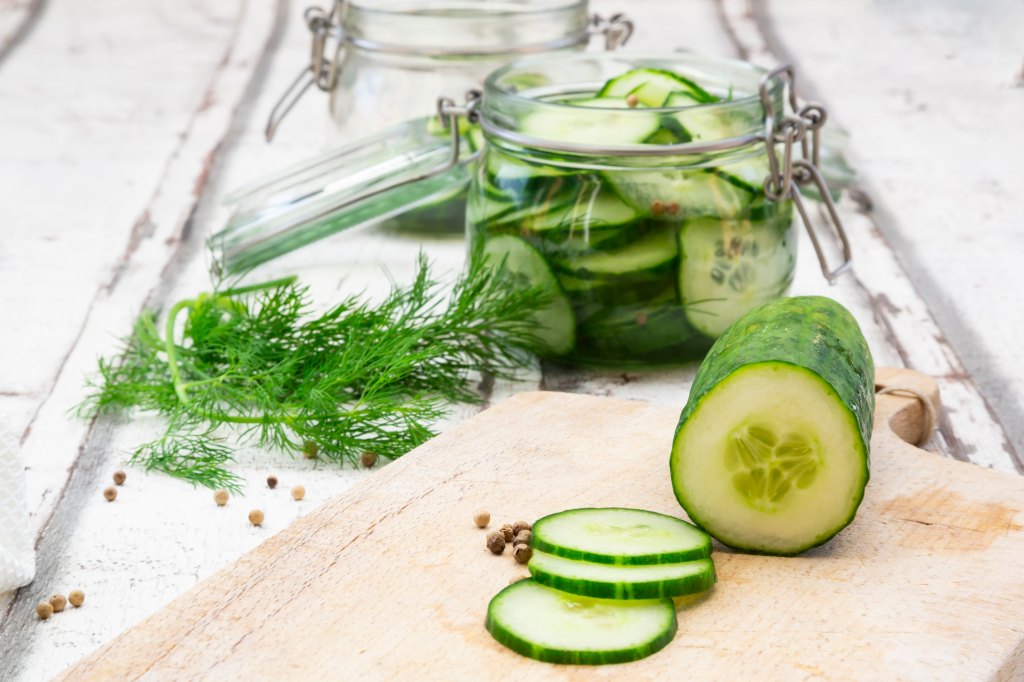Any cucumbers in your fridge that didn’t make the cut for your summer salad or flavored water shouldn’t go to waste. In fact, the best way to enjoy them for a few extra weeks is by turning them into homemade pickles. Making your own pickles keeps those cukes fresher longer, and is the perfect addition to burgers, sandwiches or another savory dish of your liking. Even better, it takes just 15 minutes to prep the pickled cucumbers to be stored in the fridge. Keep reading for tips on how to pickle cucumbers, including the best types of cucumbers to use for pickling!
The basics of pickles
Pickles are made by submerging a jar full of cucumbers in a brine, typically containing salt, water, granulated sugar, vinegar, and seasonings. This combination of ingredients not only adds flavor but also preserves the cucumbers by creating an acidic environment that wards off harmful bacteria. After sealing the jar, the cucumbers are left to pickle for anywhere from a few hours for a milder taste, to several weeks for a deeper, more intense flavor.
There are two main types of pickling: quick pickling and fermentation. Quick pickling, the more common method, involves soaking cucumbers in a vinegar-based brine and doesn’t require refrigeration. Fermented pickles, on the other hand, use saltwater and are left at room temperature to naturally develop a tangy flavor through fermentation, a process in which natural bacteria transform the sugars in cucumbers into lactic acid. This gives fermented pickles their distinct taste and probiotic benefits.
Once your pickles are ready, they can add a burst of flavor to a variety of dishes. Try adding them to sandwiches, salads, or wraps, or enjoy them straight from the jar as a low-calorie, savory snack. With their versatility and flavor, pickles are a unique addition to almost any meal.
Best cucumbers for pickling
In order to produce crunchy pickles, you’ll want to use the right cucumbers for the job. Common varieties like Kirby, Boston pickling and Bush cucumbers are great choices as they have thin skin and firm flesh — which prevents them from becoming mushy. In addition to selecting the correct cucumbers, slicing them allows the brine to penetrate the flesh. This creates a more flavorful batch of pickles, and makes it easier to serve them right away.
Easy method for pickling cucumbers at home
You may think the process of making pickles involves an extensive process of sterilizing the jars and lids. But, there’s a simpler method that requires just 15 minutes of prep. Simply pour the prepared brine over the sliced cucumbers, close the jar tightly and store it in the fridge. This method doesn’t require sterilization as the fridge does all of the work of slowing down the rate of spoilage and bacteria growth. However, it’s still a good idea to make sure the jar is clean to avoid any cross contamination. When prepared correctly, refrigerator pickles make any dish, from grilled burgers to hearty protein bowls, extra delicious!
How to pickle cucumbers in the fridge
This Fridge Pickles recipe from our test kitchen is hassle-free and produces a condiment that rivals the store-bought version. While the recipe uses fresh dill for a classic herby flavor, other add-ins such as whole peppercorns, red pepper flakes, mustard seeds or garlic cloves work fine too. These pickles will last around three to four weeks in the fridge, giving you plenty of time to enjoy them. (Be sure to use that excess pickle brine from the jar to make a Pickle Margarita or these dishes from our stories on using pickle juice for cooking.)
Fridge Pickles

Ingredients:
- 1 cup cucumber slices
- ¾ cup hot water
- ¾ cup apple cider vinegar
- 2 tsp. salt
- 2 tsp. sugar
- 2 Tbs. fresh dill
Directions:
- In bowl or measuring cup, combine hot water, apple cider vinegar, salt, sugar until fully dissolved. Cool completely.
- Place cucumber slices in large jar with enough room on top. Sprinkle in fresh dill before pouring in brine. Close jar with lid and shake to ensure ingredients are thoroughly combined.
- Store in fridge for 3 to 4 weeks. Enjoy as a solo snack or condiment for dishes.




